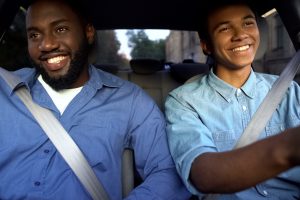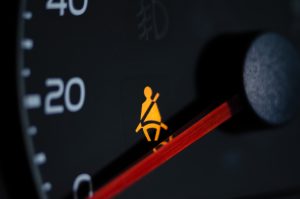
There is no question that wearing a seat belt can save your life in a crash. Although we have achieved a high rate of seat belt compliance in Maryland (roughly 91 percent), we still have work to do. Hundreds of unrestrained drivers are injured or killed each year in crashes on our roads. In fact, you’re more than four times more likely to die in a crash if you’re unrestrained. So, why do some people still refuse to buckle up? Here we discuss some of the myths and misguided reasons why people choose not to wear seat belts, and why they’re mistaken.
- Do I need a seat belt? Just because you are careful does not mean you won’t be in a crash. You cannot control what other drivers do. Another driver might be distracted, impaired, or driving aggressively and crash into you. You can control how you prepare for this possibility — be safe and buckle up every time you get in the car.
- What if I feel restrained? You might. That’s what seat belts are designed to do. Without something restraining you, you would fly forward at the same rate of speed the car was traveling at the moment of impact. A properly worn three-point safety belt, which includes a shoulder and lap belt, prevents you from becoming a projectile during a crash, potentially hitting other passengers or being ejected from the vehicle.
- What if the seat belt is uncomfortable? If your seat belt is uncomfortable, many cars allow you to adjust the height on the vehicles seat and shoulder belt to ensure the strap goes across your chest. Always sit up straight while driving, this will give you the best visibility and keep the belt pressure even across your body. If you’re still uncomfortable, move your hips in toward the buckle/interior of the vehicle about .05-1” to move your body away from where the shoulder belt rubs on your neck. It might also help to consider that the minor discomfort of a seat belt will prevent the major discomfort caused by injuries from a crash.

Yellow lit Warning lamp not wearing a seat belt close up
- What if I forget to buckle up? Since 1973, passenger vehicles in the United States have been required to include an audible reminder for drivers to buckle up. Even without these reminders, you should know by now how important it is. Make it a habit.
- What if I’m too big or tall to wear a seat belt? Seat belt extenders are available to make riding safely possible for larger and taller passengers. These add to the overall length of the seat belt and should only be utilized by teens or adults who are unable to fasten their seat belt without additional length. When an extender must be used, it should be obtained directly from the vehicle manufacturer. It may be unsafe to utilize an extender obtained from a third-party as it has the potential to fail in a crash.
- What if I’m driving slow or close to home? These are not acceptable excuses to not wear a seat belt. Injury or death can still occur in a crash at low speeds and is much more likely to occur to unbelted passengers. Most fatal crashes occur at speeds under 40 mph and half of all car crashes happen within five miles of a person’s home.
- What if I need to exit the car quickly? This tends to go hand in hand with the previous excuse. People who are driving a short distance to pick up fast food or drop off something at a neighbor’s house are often willing to risk riding unrestrained, just to get in and out of their car quickly. Buckling and unbuckling a seat belt adds only few seconds to your trip each way. If you think this is inconvenient, consider the inconvenience of a trip to the hospital (or worse).
- Could I get stuck in the car during a crash? In the event of a crash, it’s far better to remain in the vehicle than to be ejected. You’re more than four times more likely to die if ejected than if you are safely buckled. Although situations where there the car is on fire or submerged in water are rare, you’re much more likely to be conscious after impact, and in a stable condition to exit the vehicle, if you’re wearing a seat belt.
- What if have a medical condition that prevents me from wearing a seat belt? There are no specific medical conditions that automatically exempt you from seat belt laws. It’s a common myth, for example, that women should not wear seat belts during pregnancy. See NHTSA’s guidance for seat belt recommendations for pregnant women. Except for rare circumstances which must be documented by your physician, you must wear a seat belt. If you obtain this documentation, you must carry it with you in your car at all times.
- Won’t the seat belt cause injuries during a crash? While it’s true that many people sustain minor injuries like bruising from their seat belts during a crash, it’s nothing compared to the injuries that unrestrained passengers endure. Think about the force with which your body might hit the dashboard of the car. That’s assuming your body remains in the car. Passengers not wearing seatbelts are likely to be partially or completely ejected from the vehicle through the windshield or a side window. This can result in severe lacerations, broken bones, or internal bleeding. You may end up with a traumatic brain injury, cracked skull, or spinal cord damage, possibly resulting in permanent paralysis or death.
- If my car has an air bag, that will protect me right? Incorrect. Airbags serve as “supplemental restraint systems,” hence that SRS tag you see identifying them within your car. Safety engineers design airbags to work with seat belts, not instead of seat belts. They increase the effectiveness of vehicle restraints by providing additional protection for your head, neck, and chest. You will not be correctly positioned for this protection if you’re not wearing a seat belt and could sustain additional injuries as a result.
- I’m driving a bigger vehicle; won’t it protect me in case of a crash? We suspect this is one of the reasons we see so many fatalities involving unrestrained drivers in trucks and SUVs. Fatalities are common in these vehicles when drivers are not wearing safety belts. The size of your vehicle will not save your life in a crash if you are not wearing a seat belt.
- I have good reflexes, can’t I brace myself in a crash? Ask anyone who’s been in a car crash — it happens in a split second. Even if you were able to anticipate the crash, bracing yourself would unlikely make a difference. In a crash at only 40 miles per hour, you’d be hit with the approximate force of a 17-meter fall. To put this in perspective, this is like falling from a four-story building.
- What if I choose not to wear a seat belt despite the risks? There’s a subset of people who don’t wear seat belts who believe it’s no one else’s business, because not wearing a seat belt doesn’t impact anyone else. However, the decision to not wear a seat belt can and does affect others, sometimes quite literally. People not wearing seat belts become a projectile during a crash. It’s common for unrestrained back seat riders to fly forward, crash into someone in the front seat, and kill them.
No Excuses: Buckle Up, Every Seat, Every Ride
Seat belt statistics speak for themselves. Seat belts save lives and there is no excuse not to wear one. Not wearing a seat belt doesn’t make you cool; it makes you reckless. You’re endangering yourself and everyone else in your car. Whether you’re a passenger or a driver, make sure everyone in your car buckles up every time. No excuses.